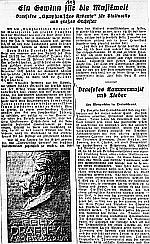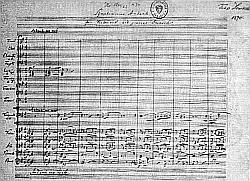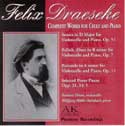Felix Draeseke: Symphonic Andante in E minor for Cello and Orchestra, WoO 11
|
Originally presented at the 20th Conference of the IDG, Coburg, June 2006. |
|
|
|
Felix Draeseke composed in all categories of music, but the number of works for solo instrument and orchestra is limited, for there are only four such works. The next to last, the Concerto in E flat major for Piano and Orchestra, Op. 36 comes from the year 1889 and remains to the present the sole concert piece for solo instrument and orchestra which has been done in public more than once, indeed was printed and presently exists in two CD recordings. Following this, in 1910 toward the end of the composer's life there appeared a most individual and truly beautiful Concert Piece for Harp and Orchestra, WoO 36 titled Feenzauber (Fairy Magic). Directly preceding the piano concerto stands the 1881 Violin Concerto in E minor, WoO 15, unplayed to this day with the orchestral score and parts lost since 1942 – although it was performed by violinist Julia Röntz und Draeseke expert Wolfgang Müller–Steinbach at the piano during the June 2009 meeting of the International Draeseke Society in Meiningen from the complete and available violin and piano reduction of the work from the Saxon State Library in Dresden – a premiere to be sure. Finally mentioned here is really the first of these works for solo instrument and orchestra: the Symphonic Andante in E minor for Cello and Orchestra, WoO 11. The work may be regarded as the last work fully completed during Draeseke's fourteen-year residence in the French speaking part of Switzerland when, in 1876, he returned to Germany for the rest of his life. The term “completed” in this case may be regarded as questionable, since the nature of the composition exhibits some of the most peculiar attitudes and considerations Draeseke ever exhibited in his works. According to the manuscript, this Symphonic Andante for Cello and Orchestra is complete, but everywhere there are intentionally empty measures in the cello part, which the soloist is to either freely improvise or otherwise fill in with original cadenza-like material during a performance! That is probably the major reason that the work – as far as can be ascertained – has only been played once: during the 1935 hundredth anniversary celebrations of Draeseke's birth in Coburg and in a version by the Coburg cellist, Hans Peters Marquardt, which can be examined and studied in the holdings of Peters Marquardt bequeathed the Coburg State Archives. Apparently Peters Marquardt played the work only once. It's quite possible that Draeseke wanted to emphasize the term symphonic in the title, since he never once during the near 40 years remaining to him attempted a transcription for cello and piano, perhaps fearing that as such the work would be regarded merely as a salon piece. Though it was rumored that someone ca. 1990 had indeed made a cello-piano reduction of the work and even played it in public, no proofs have been forthcoming despite careful research. By necessity there will be a cello-piano reduction forthcoming when the work in full orchestral garb is published and that presents welcome opportunity to become acquainted with the truly wonderful thematic material: but the orchestral garb is a major feature of appreciation. From personal knowledge of the full orchestral score, this writer maintains that the Symphonic Andante is a model of melodic invention, a work truly thought of in terms of the orchestra and one which shares the spirit of the Ballad and the Barcarole for Cello and Piano, Opp 7 and 11 respectively, also works from the Swiss period. Just before the world premiere 1935 in Coburg Peters Marquardt wrote about the work as follows:
Two different reports concerning the concert in the Moritzkirche in which the Symphonic Andante was played are available and both can be readily viewed in the original German in the Ebert-Sammlung on the Draeseke website. The first of these comes from Dieter Schammberger, director of music for the church. Referring to the Symphonic Andante he comments in the following manner: “For the commencement, church music director Dieter Schammberer [sic!] played a short chorale prelude on O Ewigkeit, o Donnerwort and then the prelude to the mysterium Christus as transcribed for organ by E. Schnorr von Carolsfeld, which in this form could foster appreciation of its strict form. Thereafter, Peters Marquardt brought the performance of his recently rediscovered Symphonic Andante for Violoncello Solo and Orchestra, the premiere of which had been generously accorded attention in pre-concert talks; although it did not seem to easily fit the discussion stylistically, it nevertheless proved itself to be worthwhile. In and of itself it is a thankful composition for the instrument and with thoroughly original, though for me, also containing conventional characteristics: it seems uncertain whether it is the rudiments of a planned cello concerto or meant as an independent composition. Peters Marquardt appeared in the guise of a tastefully performing virtuoso charge with a thankful task.” Alfred Wang described the performance in the following manner: “The Symphonic Andante for Cello and Orchestra is a work from an earlier creative period of Felix Draeseke which could receive its world premiere through the efforts of our richly acclaimed F. Peters Marquardt of the municipal theatre orchestra. This Andante is not an occasional piece, revealing as it does in its basically elegiac countenance and thematic working many a characteristic element in the stylistic development of this master. A highly satisfying task has been provided the solo instrument, and one which Peters Marquardt dispatched with lovely warm tonal production and great musical ability.” As far as can be ascertained, these are the sole lines referring to the work which have remained, and they hold admittedly limited information. The composer's manuscript is to be found in the Draeseke collection of the Saxon State Library (Sächsiche Landesbibliothek Staats-und Universitätsbiliothek) Dresden with the catalog indication Signatur MUS 7099-0-500.
Alan Krueck |
| Read the English version | Felix Draeseke: das Symphonische Andante für Cello und Orchester, WoO 11 Felix Draeseke komponierte in allen Gattungen der Musik, aber gering ist die Anzahl seiner Werke für Solo-Instrument mit Orchester. Es gibt nur vier solche Stücke. Als Vorletzte der Reihe erschien das Konzert in Es-Dur für Klavier und Orchester Op. 36 aus dem Jahr 1889, und bis heute bleibt es das Einzige der Konzertstücke für ein Solo-Instrument, das je mehr als einmal die Öffentlichkeit erlebt hat, sogar gedruckt wurde und zweimal für CD eingespielt worden ist. Darauf folgend gegen Ende des Lebens des Komponisten 1910 erschien ein höchst eigenartiges, aber in der Tat wunderschönes Konzertstück för Harfe und Orchester, WoO 36 Feenzauber genannt. Dem Klavierkonzert direkt voran steht das bis auf den heutigen Tag nicht aufgeführte, in E-moll geschriebene und 1881 komponierte Violinkonzert, WoO 15, dessen Partitur und Orchestermaterial ab 1942 verschwunden sind – der einzige Grund warum das Werk auch nicht in der Nachkriegszeit uraufgeführt worden ist (bei der IDG Tagung 2009 die vorhandene und vollständige Fassung für Violine und Klavier von den SLUB Draeseke-Archiven von der Geigerin Julia Röntz und dem Draeseke Kenner Wolfgang Müller-Steinbach am Klavier in Meiningen gespielt wurde und dient also als eine Uraufführung.). Zuletzt wird das erstkomponiertierte dieser Soloinstrument mit Orchester verfassten Werke erwähnt: das Symphonische Andante E moll für Cello und Orchester WoO 11. Das Werk darf als die letzte in der Schweiz vollendete Komposition von Draeseke betrachtet werden, ehe er 1876 nach Deutschland auf immer zurücksiedelte. Aber der Begriff vollendet in diesem Fall darf als fragwürdig betrachtet werden, weil die Natur des Werkes die merkwürdigsten Anschauungen und Auslegungen Draesekes darstellt. Der Handschrift nach ist dieses Symphonische Andante für Cello und Orchester abgeschlossen, aber es herrschen darin absichtlich freigelassene Stellen welche der Solist selbst hineinkomponieren oder frei während der Aufführung improviseren soll. Das ist höchstwahrscheinlich der Grund, daß das Stück - so weit nachgewiesen werden kann – nur einmal öffentlich gespielt worden ist,und zwar während der Coburger Draeseke 100 Jahresfeier 1935 in einer Fassung von dem Coburger Cellisten Franz Peters-Marquardt, welche in seinem Nachlaß in dem Coburger Stadtarchiv anzusehen und zu studieren ist. Augenscheinlich hat Peters-Marquardt das Werk nur einmal vorgetragen. Draeseke wollte die Bezeichnung symphonische an dem Stück betonen und versuchte nicht einmal in den fast ihm 40 verbleibenden Jahres seines Lebens eine Übertragung für Cello und Klavier zu schaffen, wohl aus Angst, daß die Komposition sonst als Salonstück anbetrachtet werden könnte.Allerdings würde es sich doch lohnen, eine Cello und Klavier Fassung herstellen zu lassen, allein die wunderschöne Thematik hören zu können, da von meiner Kenntnis des Werkes Partitur, d.h das Symphonischen Andantes, ein Prachtstück der melodischen Erfindung darstellt, eine echte orchestral erdachte Musik, die aus dem Geiste der Ballade und der Barcarole für Cello und Klavier Opp. 6 und 7 entsprungen ist. Über das Werk schrieb Peters-Marquardt 1935 vor der Uraufführung folgendes im Coburger Tageblatt:
Hier verrät Peters-Marquardt, daß das Stück nicht als Teil eines gewöhnlichen abendfüllenden Orchesterkonzerts in einem Konzertsaal stattfinden soll, sondern eher als Zwischenspiel zwischen Kirchenmusikstücken in der Moritzkirche von Coburg - in Wahrheit zwischen Orgelmusik und einem großangelegten Chorwerk (allerdings dem H-moll Requiem Op. 22 !). Weiter schreibt Peters-Marquardt über seine Arbeit an dem Stück in der Vorbereitung zur Aufführung. Über Details seiner Bearbeitung schweigt er, aber Peters-Marquardt in einer Nebenbemerkung gegen Schluß des Zeitungsartikel gebraucht das Wort “vervollständigen” - ein klarer Hinweis auf die vom Komponisten absichtlich leergelassenen Stellen für Soloinstrument in der sonst abgeschlossenen Partitur. Zweierlei Nachrichten über das Kirchenmusikonzert, worin das Symphonische Andante gespielt wurde, sind vorhanden und können bei der Ebert-Sammlung an der Draeseke Webseite leicht gelesen werden. Die Erste stammt vom Kirchenmusikdirektor Dieter Schammberger und in bezug auf das Symphonische Andante lautet folgendermassen: “Eingangs spielte Kirchenmusikdirektor Schammberger ein kurzes Choralvorspiel zu O Ewigketi, o Donnerwort und das von E. Schnorr von Carolsfeld für Orgel übertragene Vorspiel zum Mysterium Christus, von dessem (sic!) strengen Stil man wenigstens in dieser Form eine Ahnung bekommen konnte. In Anschluß daran brachte F. Peters Marquardt die in den Vorbesprechungen gebührend gewürdigte Uraufführung eines von ihm wieder aufgefundenen Symphonischen Andantes für Violoncello Solo und großes Orchester, das sich zwar stilistisch nicht gut einfügen wollte, aber sich dennoch als wertvoll erwies, um zur Erörterung gestellt zu werden. Für sich eine dankbare Komposition für das Instrument und mit durchaus eigenen aber auch mir konventionellen Zügen behaftet, bleibt es ungewiß ob es das Rudiment eines geplanten Cellokonzertes ist oder als selbstständige Komposition zu gelten hat. Peters-Marquardt hat sich als sehr geschmackvoll spielender Virtuose vor eine dankbare Aufgabe gestellt.” Von Alfred Wang wurde die Aufführung in folgenderweise beschrieben:“Ein Werk aus einer früheren Schaffensperiode Felix Draesekes ist das Symphonische Andante für Cello und Orchester, das dank der Bemühungen unseres hochverdienten F. Peters-Marquardt vom Landestheater seine Uraufführung erleben konnte. Das Andante ist zwar eine Gelgenheitskomposition, weist aber in seiner elegischen Grundstimmung und seiner thematischen Durcharbeitung manche für die Stilentwicklung des Meisters charakteristische Züge auf. Dem Soloinstrument bietet sich eine höchst dankbare Aufgabe, deren sich Peters Marquardt mit schöner warmer Tongebung und grossem musikalischen Können entledigte.” So weit sind diese, die einzig entdeckten Zeilen welche auf das Werk hinweisen, die uns aber erkennbar wenig informieren.
Alan Krueck |
| News: The rehearsal version for cello and piano of the Symphonic Andante, was recently performed (Feb 2010) by Barbara Thiem, Cello and Teresa Bogard, Piano at Colorado State University, Fort Collins, CO. | |
| Draeseke's Chamber Music for Cello on CD: | |
AK Coburg DR 0002 [CD] Sonata for Cello and Piano in D op. 51
Read Henry Fogel's review from Fanfare. |
|
[Chamber Music] [Orchestral Music] [Keyboard Music] [Listen: mp3 ] [Top]
© All contents copyright by the International Draeseke Society


